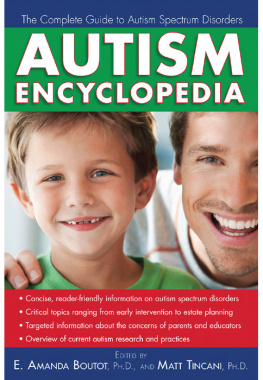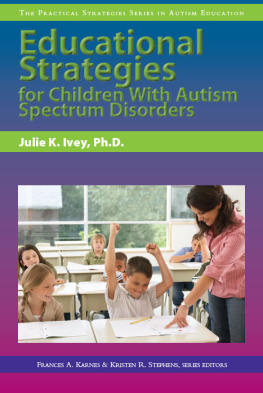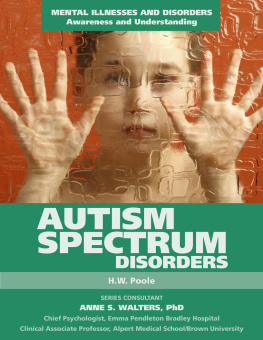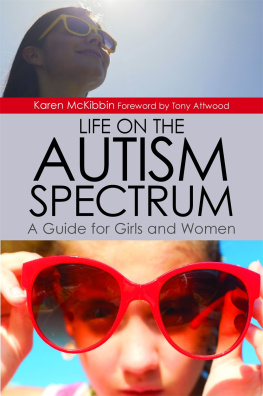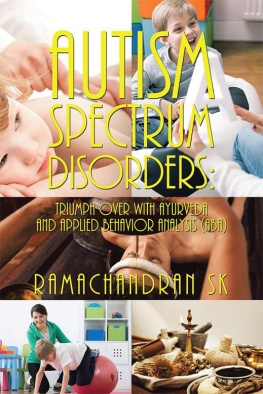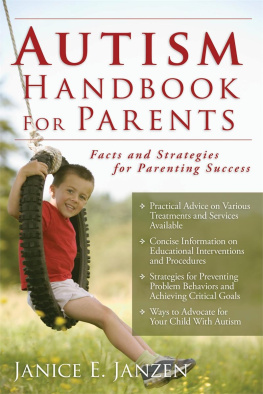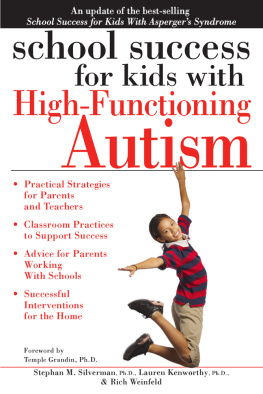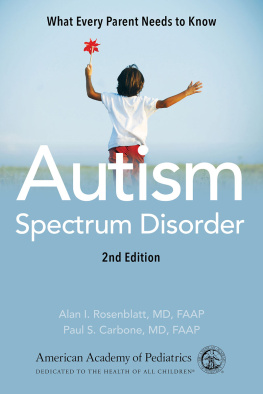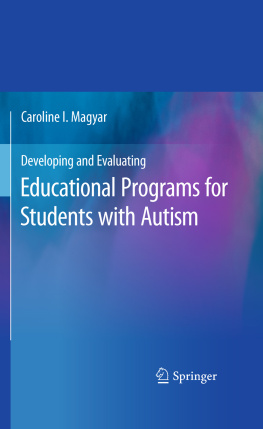The Complete Guide to Autism Spectrum Disorders
AUTISM ENCYCLOPEDIA
EDITED BY
E. AMANDA BOUTOT, PH.D., AND MATT TINCANI, PH.D.

PRUFROCK PRESS INC.
WACO, TEXAS
2009 Prufrock Press Inc.
This work and the contents herein are published under a license with PRO-ED, Inc. and is also currently published by PRO-ED, Inc. under the title Autism Spectrum Disorders Handouts: What Parents Need to Know. 2006 by PRO-ED, Inc., 8700 Shoal Creek Boulevard, Austin, Texas, 78757-6897,Tel. (800) 897-3202, Fax. (800)397-7633, www.proedinc.com.
Edited by Rich Restaino
Cover and Layout Design by Marjorie Parker
ISBN-13:978-1-59363-469-8
ISBN-10:1-59363-469-2
No part of this book may be reproduced, translated, stored in a retrieval system, or transmitted, in any form or by any means, electronic, mechanical, photocopying, microfilming, recording, or otherwise, without written permission from the publisher.
Printed in the United States of America.
At the time of this books publication, all facts and figures cited are the most current available. All telephone numbers, addresses, and Web site URLs are accurate and active. All publications, organizations, Web sites, and other resources exist as described in the book, and all have been verified. The authors and Prufrock Press Inc., make no warranty or guarantee concerning the information and materials given out by organizations or content found at Web sites, and we are not responsible for any changes that occur after this books publication. If you find an error, please contact Prufrock Press Inc.

Prufrock Press Inc.
P.O. Box 8813
Waco, TX 76714-8813
Phone: (800) 998-2208
Fax: (800) 240-0333
http://www.prufrock.com
ACKNOWLEDGMENT
The editors wish to thank Ms. Tracee Guenther for her tireless dedication to the completion of this project.
HOW TO USE THIS BOOK
I N order to serve and advocate for children with autism spectrum disorders (ASD), parents, teachers, and other caretakers are faced with gathering and understanding a massive amount of information. Whereas other resources can be cumbersome and time-consuming, Autism Encyclopedia: The Complete Guide to Autism Spectrum Disorders offers concise, reader-friendly articles that provide answers on the most pertinent questions related to educating and parenting children with autism.
Written and edited by professional special educators and researchers, the entries explain and give practical advice on topics including the educational process; programs for young children with autism; issues in communication, behavior, and social skills; promoting functional living skills, friendships, and inclusion; and caring for adults with autism. Current research and emerging issues in treating ASD also are discussed.
Unlike some encyclopedias that use an A-Z format, the Autism Encyclopedia is organized by topic. Entries are grouped together under umbrella headings, such as Overview of Autism Spectrum Disorders, Issues in Social Skills, and Promoting Friendships and Inclusion. Under each umbrella heading are articles that deal with a more specific topic, sometimes framed in the form of a frequently asked question, such as How is an autism spectrum disorder diagnosed? For those seeking quick access to specific terms, consulting the alphabetized index may prove more convenient.
Each entry contains a glossary of key terms and suggested resources for more information. Topics are cross-referenced for easy access to related articles. For example, after reading the entry on Early Intervention Services, you may be interested in learning more about assistive technology. The Autism Encyclopedia makes it easy to find related topics by including page-numbered references after each entry.
The special education specialist may find it useful to use entries to help address specific concerns or questions of general education teachers or parents of children with autism spectrum disorders at IEP meetings or parent-teacher conferences. The book also may be used as part of professional development. Although useful to the professional, the entries are free of unnecessary jargon and are directed at parents seeking a more direct and active role in their childs education and development.
Perfect for parents navigating the educational system with their child, inclusion teachers, or specialists seeking a quick reference guide, the Autism Encyclopedia will empower all stakeholders with the information and best practices they need to help ensure success for children with ASD.
DESCRIPTION OF CONTENTS
Entries in this book are organized into 10 major topics:
- Introduction: Emerging Issues in Causes, Assessment, and Intervention provides an overview of the most up-to-date research on the major emerging issues related to the causes and assessment of autism spectrum disorders, as well as intervention techniques.
- Section 1: Overview of Autism Spectrum Disorders provides a general description of autism spectrum disorders and their diagnosis.
- Section 2: The Educational Process explains the U.S. special education system and how parents can best plan their childs education.
- Section 3: Programs for Young Children With Autism offers an overview of the different services available for young children with autism.
- Section 4: Issues in Communication highlights the different styles of communication that may be used with a child with an ASD.
- Section 5: Issues in Behavior describes variations in the stimulation of positive behaviors for a child with an ASD.
- Section 6: Issues in Social Skills describes three ways to teach social skills to a child with autism.
- Section 7: Functional Living Skills covers several strategies for assisting a child with autism in mastering daily living skills.
- Section 8: Promoting Friendships and Inclusion offers parents information on the practice of inclusion and how it will affect their child with autism.
- Section 9: Transition describes the tools necessary for a successful transition from the education system to the adult world.
INTRODUCTION: EMERGING ISSUES IN CAUSES, ASSESSMENT, AND INTERVENTION
Matt Tincani and Stacie Groeling
T HEAutism Encyclopedia covers a variety of topics in the field of autism spectrum disorders (ASD). Our intent was to create an accessible, yet comprehensive guide for parents and professionals who wish to learn more about ASD. Within the pages of the Autism Encyclopedia, readers will discover a variety of topics, including programs for early intervention, techniques to promote communication and social skills, and strategies to reduce challenging behavior.
There has been much recent coverage of ASD within the media. Although the exact reasons why children develop ASD are still not well understood, researchers are working hard to identify the genetic, behavioral, and environmental risk factors underlying these conditions. At the same time, rapid strides are being made in the science of early detection and intervention. For example, a substantial body of research now suggests that young children with autism who are exposed to early, intensive interventions based in applied behavior analysis (ABA; see Entry 3.5) make a great deal of educational progress compared to those who are not. Teaching techniques derived from ABAsuch as prompting, shaping, fading, and use of positive reinforcement are described throughout this book. More than ever, children with ASD have the opportunity to learn new skills through the systematic applications of ABA and other research-based intervention techniques.
Next page
